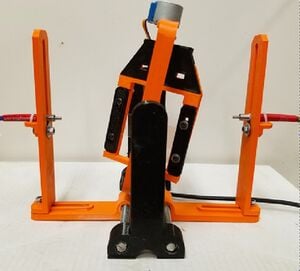
Simple 3-D printable open source hardware designs have proven to be effective scientific instruments at low costs. Further development in this area is coupling open source electronics with 3-D printable mechanical components to make fully functional distributedly-manufactured mechatronic tools for science. One research area where such low-cost technology is needed is to characterize thin film anti-reflective coatings and transparent conducting oxides (TCOs) for the glass, mirror and solar photovoltaic industry whose transmission properties are angle dependent. To meet this research need a low-cost 3-D printable open source dual axis gimbal system is presented in this study. An Arduino based microcontroller is used to move the sample holder to the user specified angle where two stepper motors control the motion providing two degrees of freedom. The sample holder is made in such a way that samples can easily be mounted on it by two movable latches. The system was validated and characterized for: i) unidirectional accuracy, ii) repeatability, iii) backlash, iv) speed resolution and v) microstep size. Finally, the mechatronic system is tested for the intended application using a halogen light source and a spectrometer to measure transmission through glass TCO samples through a hemisphere. The system performed as expected has a unidirectional accuracy of 2.827°, repeatability of 1.585°, backlash error of 1.237°, maximum speed of 35.156° and a verifiable microstep size of 0.33°. Despite the highest mean squared errors, the open source gimbal system performed adequately while measuring transmission of radiation through glass with TCO coatings. This open source system also represents a 96% cost in savings as compared to the least expensive commercial variant. The high mean squared errors are offset by the cost of the system coupled with its open source nature that promotes further collaboration and hence, development.
- Repository contains all source code, paper contains instructions
- Quick download of stls []
- mastercad assembly - https://github.com/goscommons/Dual-Axis-Gimbal-System
Highlights[edit | edit source]
- Low-cost 3-D printable open source dual axis gimbal system is presented.
- Arduino based microcontroller used to move over two degrees of freedom.
- Had unidirectional accuracy of 2.827°, repeatability of 1.585°, backlash error of 1.237°.
- Maximum speed of 35.156° per second and a verifiable microstep size of 0.33°.
- 96% cost in savings as compared to the least expensive commercial variant.
See also[edit | edit source]
- Open Source Lab
- Open-source 3D-printable optics equipment
- Building research equipment with free, open-source hardware
- Open source science
- Open-source hardware
- Open-source syringe pump
- Open Source 3-D Printed Nutating Mixer
- Open Source Laboratory Sample Rotator Mixer and Shaker
- Open Source Digitally Replicable Lab-Grade Scales
- Open Source Vacuum Oven Design for Low-Temperature Drying: Performance Evaluation for Recycled PET and Biomass
- MOST
- Papers
- Projects
- SDG08 Decent work and economic growth
- SDG09 Industry innovation and infrastructure
- 2018
- MOST completed projects and publications
- Optics
- Science
- Physics
- Photovoltaics
- OSAT 3D-Printable Designs
- Open source hardware
- Open source
- Open source optics
- Open source scientific hardware
- 3D printing
- Open hardware
- Plastic





